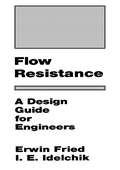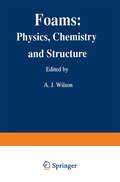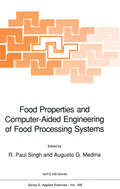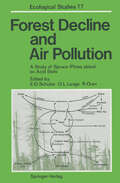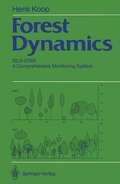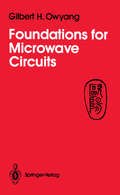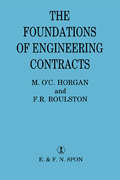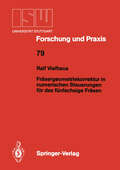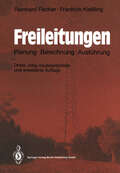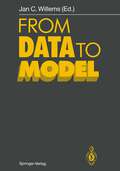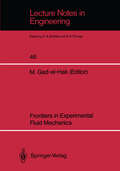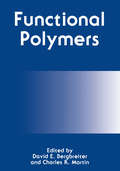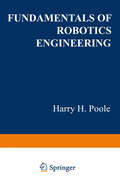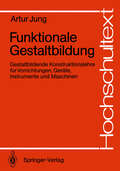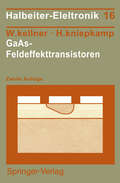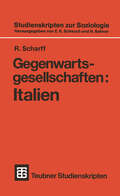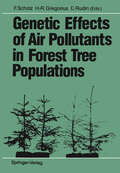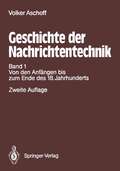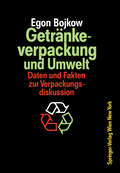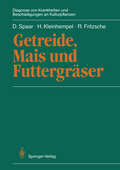- Table View
- List View
Flow Resistance: Design Guide For Engineers
by I.E. IdelchikA sourcebook offering an up-to-date perspective on a variety of topics and using practical, applications-oriented data necessary for the design and evaluation of internal fluid system pressure losses. It has been prepared for the practicing engineer who understands fluid-flow fundamentals.
Flow Resistance: A Design Guide for Engineers
by I.E. IdelchikA sourcebook offering an up-to-date perspective on a variety of topics and using practical, applications-oriented data necessary for the design and evaluation of internal fluid system pressure losses. It has been prepared for the practicing engineer who understands fluid-flow fundamentals.
Foams: Physics, Chemistry and Structure (Springer Series in Applied Biology)
by Ashley J. WilsonFoams and froths are an important feature of everyday life; one only has to think of shaving foam, foam upholstery, fire fighting foam, bread, bear head, and ice cream. Less obvious but equally important are the foams and foaming processes which are being exploited in ever more complex and imaginative ways in industry. However, the unusual nature of foams, the fact that they are neither solids or liquids, and their very fragility has prevented scientists from obtaining a thorough understanding of even the basic principles of foam formation and stability. This volume presents papers on the physics, chemistry, structure and ultrastructure of foams by contributors from a wide range of backgrounds and research disciplines. The aim of the book is to present a unique multi-disciplinary cross section of work currently being undertaken on the subject of foams.
Food Properties and Computer-Aided Engineering of Food Processing Systems (NATO Science Series E: #168)
by R. P. Singh Augusto G. MedinaFood properties, whether they concern the physical, thermodynamic, chemical, nutritional or sensory characteristics of foods, play an important role in food processing. In our quest to gain a mechanistic understanding of changes occurring during food processing, the knowledge of food properties is essential. Quantitative information on the food properties is necessary in the design and operation of food processing equipment. Foods, because of their biological nature and variability, vary in the magnitude of their properties. The variation in properties offer a challenge both in their measurement and use in the food processing applications. Often a high level of precision in measurement of properties is not possible as the measurement method may itself cause changes to the product, resulting in a variation in the obtained values. Recognizing the difficulties in measurement of food properties, and the lack of completeness of such information, several research programs have been in existence during the last two decades. In Europe, a multinational effort has been underway since 1978. The first project supported by COST (European Cooperation in the Field of Scientific and Technical Research), was titled COST 90 "The Effect of Processing on the Physical Properties of Foodstuffs". This and another project COST 90bis have considerably added to our knowledge of measurement methods and data on a number of physical properties. Two publications that summarize the work conducted under 1 2 these projects are Physical Properties of Foods and Physical Properties of Foods .
Forest Decline and Air Pollution: A Study of Spruce (Picea abies) on Acid Soils (Ecological Studies #77)
by Roswitha AscheDuring the last decade, forest decline has become increasingly apparent. The decline in forest health was often reported to be associated with air pollution. The present study on Norway spruce stands in the Fichtelgebirge analyses various processes interacting within forest ecosystems. It covers transport and deposition of air pollutants, the direct effects of pollutants on above-ground plant parts, the responses of soil to acid rain, and the changing nutrient availability, and the accompanying effects on plant metabolism and growth. The role of fungi, microorganisms and soil animals in the decline of these stands is also assessed. The volume is concluded with a synthesis evaluation of the influence of different factors, and their interactions on forest decline.
Forest Dynamics: SILVI-STAR: A Comprehensive Monitoring System
by Henk KoopNo matter what forests are used for, forest managers have to deal with interactions between individual trees and between trees and other forest organisms. To understand these interactions, long-term monitoring of spontaneous forest development is necessary. A complete monitoring system has been developed including a computer package for analysis of long-term observation of forest dynamics. The system's name, "SILVI-STAR", is an acronym of SILVIgenesis and Single-tree Three-dimensional Architecture. A method of nested plot data collection on forest architecture and plant species composition has been developed out for monitoring purposes.
Foundations for Microwave Circuits
by Gilbert H. OwyangWhile many articles have been written on microwave devices, a great majority of them are prepared for specialists dealing in specific aspects of microwave engineering. At the same time, material at a fundamental level in tutorial form is extremely limited, especially for stu dents who need to acquire basic knowledge in the field. Individuals seeking to gain a prelim inary understanding of microwave circuits are usually relegated with little success to the end less search from one reference source to another. For non-experts, sequential derivations of basic relations are rarely available and extremely difficult to locate. The purpose of this volume is to collect in one place the essential fundamental principles for a group of microwave devices. The chosen devices are those which form the basic modules found in practical microwave systems. Thus, these devices provide the crucial build ing blocks in common microwave systems, and their inherent characteristics are also the basis of some of the fundamental concepts in more complex devices. The material is presented in a continuous, self-contained manner. With the appropriate background, readers should be able to follow and understand the contents without the need for additional references.
The Foundations of Engineering Contracts
by F R **Decd** M.O'C. Horgan F.R. RoulstonThis highly readable guide explains the main features of contracts applicable to the design, construction and servicing of civil, building, electrical or mechanical works. The emphasis throughout is on practical guidance, with clear explanations of the essential elements including legality, uncertainty, undue influence, agencies, overseas works, sub-contracts and quality assurance. Numerous appendices give common terms used in contracts, typical sets of standard conditions and further useful information. The book is particularly suitable for those new to the subject who will find practical guidance on understanding contracts in a wide range of civil engineering and construction works.
The Foundations of Engineering Contracts
by F R **Decd** M.O'C. Horgan F.R. RoulstonThis highly readable guide explains the main features of contracts applicable to the design, construction and servicing of civil, building, electrical or mechanical works. The emphasis throughout is on practical guidance, with clear explanations of the essential elements including legality, uncertainty, undue influence, agencies, overseas works, sub-contracts and quality assurance. Numerous appendices give common terms used in contracts, typical sets of standard conditions and further useful information. The book is particularly suitable for those new to the subject who will find practical guidance on understanding contracts in a wide range of civil engineering and construction works.
Fräsergeometriekorrektur in numerischen Steuerungen für das fünfachsige Fräsen (ISW Forschung und Praxis #79)
by Ralf ViefhausFreileitungen: Planung, Berechnung, Ausführung
by Reinhard Fischer Friedrich KießlingBei Freileitungen hat sich in den letzten Jahren ein vielfältiger Wandel vollzogen, der bisher in der Literatur noch nicht zusammenfassend dokumentiert ist. So wurden die einschlägigen Normen und Vorschriften völlig neu gestaltet und die SI-Einheiten eingeführt. Die Möglichkeiten der Datenverarbeitung haben sich erweitert und können zunehmend für die Optimierung genutzt werden. Bei Lastannahmen für Tragwerke, bei Leiterschwingungen, bei der Ausführung der Leiter, der Armaturen und der Isolatoren liegen neue Erkenntnisse vor, neue Bauformen wurden geschaffen. Die Methoden der Montage haben sich ebenso gewandelt. Der Einfluß der Umwelt auf die Gestaltung von Freileitungen hat zugenommen. Ziel des Buches ist, die dem heutigen Stand der verfügbaren Hilfsmittel entsprechenden Planungs- und Berechnungsmethoden darzustellen, die weiterführende Literatur aufzulisten und die Leitungsbaupraxis mit besonderer Berücksichtigung der Bundesrepublik Deutschland zu schildern. Von der vorherigen Auflage unterscheidet es sich durch eine völlige Neubearbeitung und Neugestaltung des Textes mit Rücksicht auf neuere Erkenntnisse und neuere Literatur, durch erweiterten Inhalt und verbesserte Darstellung sowie das Eingehen auf die gewandelte Leitungsbaupraxis.
From Data to Model
by Jan C. WillemsThe problem of obtaining dynamical models directly from an observed time-series occurs in many fields of application. There are a number of possible approaches to this problem. In this volume a number of such points of view are exposed: the statistical time series approach, a theory of guaranted performance, and finally a deterministic approximation approach. This volume is an out-growth of a number of get-togethers sponsered by the Systems and Decision Sciences group of the International Institute of Applied Systems Analysis (IIASA) in Laxenburg, Austria. The hospitality and support of this organization is gratefully acknowledged. Jan Willems Groningen, the Netherlands May 1989 TABLE OF CONTENTS Linear System Identification- A Survey page 1 M. Deistler A Tutorial on Hankel-Norm Approximation 26 K. Glover A Deterministic Approach to Approximate Modelling 49 C. Heij and J. C. Willems Identification - a Theory of Guaranteed Estimates 135 A. B. Kurzhanski Statistical Aspects of Model Selection 215 R. Shibata Index 241 Addresses of Authors 246 LINEAR SYSTEM IDENTIFICATION· A SURVEY M. DEISTLER Abstract In this paper we give an introductory survey on the theory of identification of (in general MIMO) linear systems from (discrete) time series data. The main parts are: Structure theory for linear systems, asymptotic properties of maximum likelihood type estimators, estimation of the dynamic specification by methods based on information criteria and finally, extensions and alternative approaches such as identification of unstable systems and errors-in-variables. Keywords Linear systems, parametrization, maximum likelihood estimation, information criteria, errors-in-variables.
Frontiers in Experimental Fluid Mechanics (Lecture Notes in Engineering #46)
by Mohamed Gad-El-HakDynamical systems theory and flow control are two research areas of great current interest. These and other special situations are among the topics covered in this volume. Each article emphasizes the use of experiments to achieve better physical understanding of a particular class of flow problems. The topics covered were chosen because of their importance to the field, recent appeal, and potential for future development. The articles are comprehensive and coverage is pedagogical with a bias towards recent developments.
Functional Morphology of Feeding and Grooming in Crustacea
by Bruce E. Felgenhauer Anne. B Thistle L. WatlingAbetted by recent technological advances in scanning and transmission electron microscopy, as well as new preparative methods, these contributions examine crustacean anatomy, demonstrating (or at least inferring) the functions of morphological features. In addition to feeding and grooming, they also
Functional Morphology of Feeding and Grooming in Crustacea
by Bruce E. Felgenhauer Anne. B Thistle L. WatlingAbetted by recent technological advances in scanning and transmission electron microscopy, as well as new preparative methods, these contributions examine crustacean anatomy, demonstrating (or at least inferring) the functions of morphological features. In addition to feeding and grooming, they also
Functional Polymers
by David E. Bergbreiter R. MartinThis monograph contains manuscripts, poster abstracts and summary statements representing the contributions of a group of scientists who participated in the sixth annual Texas A&M Industry-University Cooperative Chemistry Program (IUCCP) at Texas A&M University in College Station, Texas, March 22-24, 1988. This symposium on "Functional Polymers" was organized by a university-industrial steering committee consisting of Dr. D. Keene, Hoechst Celanese; Dr. D. E. McLemore, Dow Chemical Company; Dr. B. Frushour, Monsanto Company; Dr. S. Corley, Shell Development; Dr. F. Hoffstadt, BPAmerica; Dr. D. E. Bergbreiter, Texas A&M University; Dr. C. A. J. Hoeve, Texas A&M University; Dr. C. R. Martin, Texas A&M University; Dr. A. Clearfield, Texas A&M University; and Dr. A. E. Martell, Texas A&M University. The symposium itself was generously supported by the industrial companies participating in the IUCCP program. These sponsoring chemical companies include; Shell Development Company, Dow Chemical Company, BPAmerica, Monsato Company and Hoechst Celanese. The choice of "Functional Polymers" as the subject for this symposium reflects the rapid developments occurring in the broad field of polymer science and the potential for using polymeric derivatives in many new exciting and potentially profitable applications. The invited papers and submitted posters reflect the diversity of this field and include many different topics ranging from biomedical applications of polymers to conducting polymers to use of polymers as lithographic masks and recording media. General topics included in the symposium were: photoresponsive polymers, polymer blends, electronically conductive polymers, polymers catalysts, biomedical polymers and membrane transport and permeability.
Fundamentals of Robotics Engineering
by Harry H. PooleRobotics engineering has progressed from an infant industry in 1961 to one including over 500 robot and allied firms around the world in 1989. During this growth period, many robotics books have been published, so me of which have served as industry standards. Until recently, the design of robotics sys tems has been primarily the responsibility of the mechanical engineer, and their application in factories has been the responsibility of the manufacturing engineer. Few robotics books address the many systems issues facing electron ics engineers or computer programmers. The mid-1980s witnessed a major change in the robotics field. The develop ment of advanced sensor systems (particularly vision), improvements in the intelligence area, and the desire to integrate groups of robots working together in local work cells or in factory-wide systems have greatly increased the partic ipation of electronics engineers and computer programmers. Further, as ro bots ga in mobility, they are being used in completely new areas, such as construction, firefighting, and underwater exploration, and the need for com puters and smart sensors has increased. Fundamentals af Rabaties Engineering is aimed at the practicing electrical engineer or computer analyst who needs to review the fundamentals of engi neering as applied to robotics and to understand the impact on system design caused by constraints unique to robotics. Because there are many good texts covering mechanical engineering topics, this book is limited to an overview of those topics and the effects they have on electrical design and system pro grams.
Funktionale Gestaltbildung: Gestaltbildende Konstruktionslehre für Vorrichtungen, Geräte, Instrumente und Maschinen (Hochschultext)
by Artur JungDieses Buch behandelt den konstruktiven Entwurfsvorgang, wie er sich in der Praxis in vielen Fällen darstellt, in einem vernetzten Ablaufmodell (Drei-Ebenen-Modell). Damit ergänzt es die heute üblichen Ablaufpläne und versucht, den schwierigen Vorgang der Gestaltbildung technischer Produkte aus Vorstellungen über ihre Funktionen erfaßbar zu machen. Zur Synthese und Analyse des Konstruktionsprozesses werden die Begriffe "Geometrie-Funktionsprinzip" und "Gestaltfunktion" eingeführt und an Beispielen erläutert. Das besondere Anliegen des Autors ist dabei, die geometrisch-funktionale Denkweise, die ein Konstrukteur meist unbewußt praktiziert, für den Studierenden didaktisch aufzubereiten, übergreifende Aspekte sichtbar und für den Gestaltungsvorgang nutzbar zu machen. Die behandelten Beispiele reichen von einfachen Vorrichtungen über Präzisionsinstrumente bis hin zu den genau arbeitenden Maschinen der Feinwerktechnik.
GaAs-Feldeffekttransistoren (Halbleiter-Elektronik #16)
by Walter Kellner Hermann KniepkampAus den Besprechungen: "...Das Buch wendet sich an Ingenieure, Naturwissenschaftler und Studenten, die sich in die Herstellungstechnik und Eigenschaften dieser neuen Bauelemente einarbeiten wollen. Auf Grund der hohen Bedeutung dieser Technik wurde ihr ein eigener Band in der bekannten und bereits an dieser Stelle diskutierten Reihe Halbleiter-Elektronik gewidmet. Vorausgesetzt wird die Kenntnis der Grundlagen der Halbleiter-Elektronik. Die Verfasser sind kompetente Fachleute aus der zentralen Forschung und Entwicklung der Siemens AG München ... Besonders wertvoll ist ein umfangreiches, nach den Kapiteln gegliedertes Literaturverzeichnis, das eine breite Übersicht über das Quellenmaterial und Zusatzliteratur gibt." Elektropraktiker#1 "...Nicht ohne Erfolg haben sich die beiden Autoren die Mühe gegeben, ein Buch zu schreiben, welches sowohl für "alte Hasen" als auch für Studenten geeignet ist. So können z.B. diejenigen, welche über ausreichende Grundlagenkenntnisse verfügen, die zwei ersten Kapitel überspringen, während angehende Wissenschaftler und Ingenieure gerade hier interessante und nützliche Denkanstöße finden werden..." Elektronik#2
Genetic Effects of Air Pollutants in Forest Tree Populations: Proceedings of the Joint Meeting of the IUFRO Working Parties Genetic Aspects of Air Pollution Population and Ecological Genetics Biochemical Genetics held in Großhansdorf, August 3–7, 1987
by Florian Scholz Hans-Rolf Gregorius Dag RudinAir pollutants provide environmental conditions that drastically differ in many respects from those to which forest trees are naturally adapted. Leading experts in the field here consider these questions of immediate relevance arising from the changing environment: (1) Do air pollutants introduce effects of selection that differ from those known for populations that are not subject to such stress conditions? (2) If air pollutants introduce quantitatively or even qualitatively novel selective effects, which consequences might arise from the adaptation of forest tree populations to the present conditions as well as for the preservation of adaptability to future conditions? In addition to these questions, concepts for preservation of genetic resources are discussed.
Geschichte der Nachrichtentechnik: Band 1 Beiträge zur Geschichte der Nachrichtentechnik von ihren Anfängen bis zum Ende des 18. Jahrhunderts
by Volker AschoffGetränkeverpackung und Umwelt: Auswirkungen der Verpackung von Getränken und flüssigen Molkereiprodukten auf die Umwelt Daten und Fakten zur Verpackungsdiskussion
by Egon BojkowGetreide, Mais und Futtergräser (Diagnose von Krankheiten und Beschädigungen an Kulturpflanzen)
by Dieter Spaar Helmut Kleinhempel Rolf FritzscheGewöhnliche Differentialgleichungen: Einführung in Lehre und Gebrauch (Mathematische Leitfäden)
by Harro HeuserDieses Buch ist aus Vorlesungen und Übungen entstanden, die ich mehrfach an der Universität Karlsruhe für Mathematiker, Physiker, Ingenieure und Informati ker gehalten habe. Es ist so geschrieben, daß es zum Selbststudium dienen kann: Die Gedankengänge sind ausgiebig motiviert, die Beweise detailliert, und an durchgerechneten Beispielen und gelösten Aufgaben herrscht kein Mangel. Bei der Abfassung schwebte mir vor, nicht nur ein theoretisches Gerüst aufzubau en, sondern auch eine Brücke zu den Anwendungen zu schlagen. Damit wollte ich zweierlei erreichen: erstens wollte ich ganz nüchtern und pragmatisch den Stu denten der Mathematik auf seine spätere Zusammenarbeit mit Naturwissenschaft lern und Ingenieuren einstimmen und im gleichen Atemzug auch dem "Anwen der" den Zugang zu den Differentialgleichungen erleichtern. Zweitens wollte ich - weniger nüchtern und weniger pragmatisch - den Leser auf etwas hinweisen, das zu den Wundern und Kraftquellen unserer Kultur gehört: auf die Tatsache, daß "reines" Denken, "Hirn-Gespinst" - eben Mathematik - die reale Welt nach zeichnen und umgestalten kann. Das Staunen hierüber hat denn auch alle Philo sophen ergriffen, die nicht bloß Schwadroneure waren. Und noch Einstein fragte verwundert: "Wie ist es möglich, daß die Mathematik, letztlich doch ein Produkt menschlichen Denkens, unabhängig von der Erfahrung, den wirklichen Gegeben heiten so wunderbar entspricht?" Die wissenschaftliche Revolution, die uns noch immer treibt und drängt und drückt, diese sehr revolutionäre Revolution, hat im 17. Jahrhundert begonnen, und ihre Bastillestürmer waren "Hirngespinste" par ex cellence: Newtonsche Fluxionen und Leibnizsche Differentiale.
